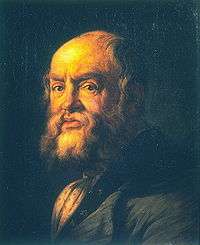Bonaventura Genelli
Giovanni Buonaventura Genelli (28 September 1798 – 13 November 1868) was a German painter.

(1838-1902)
Biography
Genelli was born at Berlin in 1798, the son of Janus Genelli, a painter whose landscapes are still preserved in the Schloss at Berlin; and grandson of Joseph Genelli, a Roman embroiderer employed to found a school of tapestries by Frederick the Great. Three uncles were architect, painter, printmaker and porcelain designer between them, and Bonaventura's son Camillo (1840–1867) was a painter. Bonaventura is mainly remembered for his Neoclassical drawings and prints in an outline style somewhat like that of John Flaxman.
Buonaventura Genelli first took lessons from his father and then became a student of the Prussian Academy of the Arts. After serving his time in the guards he went with a stipend to Rome, where he lived ten years, as friend and assistant to Joseph Anton Koch the landscape painter, a colleague of the sculptor Ernst Hähnel (1811–1891), Reinhart, Overbeck and Führich, all of whom made a name in art.
In 1830 he was commissioned by Dr. Härtel to adorn a villa at Leipzig with frescoes, but quarrelling with this patron he withdrew to Munich, where he earned a scanty livelihood at first, though he succeeded at last in acquiring repute as an illustrative and figure draughtsman. In 1859 he was appointed a professor at Weimar, where he died in 1868.
Genelli painted few pictures, and it is very rare to find his canvases in public galleries, but there in 1911 there were six of his compositions in oil in the Schack collection at Munich. These and numerous water-colors, as well as designs for engravings and lithographs, reveal an artist of considerable power - whose ideal was the antique, but who was also fascinated by the works of Michelangelo. Though a German by birth, his spirit was unlike that of Overbeck or Führich, whose art was reminiscent of the old masters of their own country. He seemed to hark back to the land of his fathers and endeavour to revive the traditions of the Italian Renaissance. Subtle in thought and powerfully conceived, his compositions are usually mythological, but full of matter, energetic and fiery in execution, and marked almost invariably by daring effects of foreshortening. Impeded by straitened means, the artist seems frequently to have drawn from imagination rather than from life, and much of his anatomy of muscle is in consequence conventional and false. But nonetheless Genelli merits his reputation as a bold and imaginative artist, and his name deserves to be remembered beyond the narrow limits of the early schools of Munich and Weimar.
His drawing Male Nude was found as part of the Munich Art Hoard.[1]
See also
Notes
- "Photo Gallery: Munich Nazi Art Stash Revealed". Spiegel. 17 November 2013. Retrieved 17 November 2013.
References

External links
![]()
